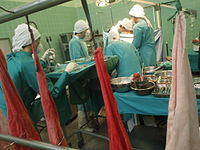
Photo from wikipedia
Apart from presenting peptides to T cells, class I HLA molecules serve as ligands for killer cell immunoglobulin‐like receptor (KIRs) and regulate the response of natural killer (NK) cells. The… Click to show full abstract
Apart from presenting peptides to T cells, class I HLA molecules serve as ligands for killer cell immunoglobulin‐like receptor (KIRs) and regulate the response of natural killer (NK) cells. The role played by HLA and KIR in the acute rejection (AR) following liver transplantation has been controversial. In this retrospective study, we assessed the influence of class I HLA alleles, HLA matching between donor–recipient pairs, recipient KIR and donor HLA ligands on AR following liver transplantation in southern Chinese. In total, 143 recipients and 78 donors obtained from a single transplant center were included in the study cohort. Thirty‐three recipients with histologically confirmed AR were observed. We found that the incidence of AR did not correlate with donor or recipient class I HLA alleles and HLA matching. Neither recipient KIR gene nor the KIR genotype was associated with AR, moreover, high‐resolution genotyping of 14 functional KIR genes of recipients showed that no KIR allele was independently associated with AR. However, the frequency of HLA‐C2+ donor significantly increased in AR group compared with NAR group (52.9% vs. 24.6%, p = 0.03). In the presence of HLA‐C2 by the donor allograft, AR was more frequently observed in recipients with normal expressed KIR2DS4 (43.8% vs. 15.0%, p = 0.03). Donor with HLA‐C2 is therefore a major determinant of AR, which can confer risk effect in liver transplantation. Our findings can provide valuable clues for better understanding pathogenesis of AR and have important clinical implications in liver transplantation for Chinese.
Journal Title: HLA
Year Published: 2022
Link to full text (if available)
Share on Social Media: Sign Up to like & get
recommendations!